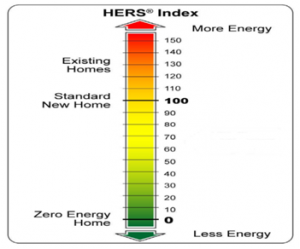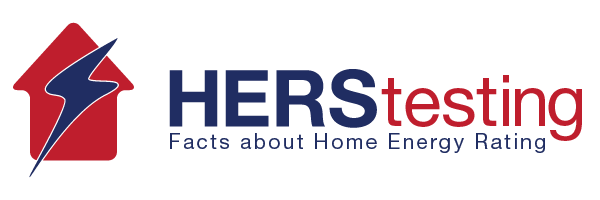The HERS testing program provides a clear, unbiased measurement of the energy efficiency of a home. A HERS Rating is used to determine whether a home meets an acceptable building quality standard. It also provides useful information which can be used to improve the home’s heating and cooling efficiency and thereby lower its energy usage. HERS ratings can be applied to new or existing single family homes as well as multi-family homes.
The HERS testing prog ram is monitored by the Residential Energy Services Network or RESNET. RESNET is responsible for setting energy compliance standards. It also oversees the training and certification of individuals that are responsible for verifying that a home meets HERS testing requirements. Check out their HERS Index Video to learn more!
ram is monitored by the Residential Energy Services Network or RESNET. RESNET is responsible for setting energy compliance standards. It also oversees the training and certification of individuals that are responsible for verifying that a home meets HERS testing requirements. Check out their HERS Index Video to learn more!
Measuring the energy efficiency of a home got its start back in the early 1980’s. However it was not until 2006 that the current HERS Index was adopted as a way to compare one home’s efficiency rating to another. Since then, the acceptance and use of HERS ratings for energy code compliance has been inconsistent from one state to the next. That is beginning to change.
With the new 2015 IECC (International Energy Conservation Code), HERS verification is now written into the code. With the new code, a maximum HERS Index Score will be a requirement of new home construction. The required score will be based on the climate zone in which home is constructed. In other words, the new home must be built to a very high energy efficiency standard and HERS testing will be used to prove it.
Keep in mind that states can adopt energy code standards at their own pace and at this writing only a few states have adopted the new 2015 code. Use the link to follow to find the current energy code used for your state.
The HERS Index
The RESNET HERS Index has become the industry standard for measuring the energy efficiency of a home. Using a systematic approach, the HERS tester will produce a number to show how much better or worse the home will perform when compared to the “standard home.” With an existing home, this rating creates a simple way to understand the home’s energy efficiency. For a new home construction, this number may be used to determine whether or not the home complies with energy code standards.
From the HERS index graphic y ou can see that the standard new home rates at a score of 100. The standard used for this graph is the average built home back in the year 2006. The lower the score the better the energy performance.
ou can see that the standard new home rates at a score of 100. The standard used for this graph is the average built home back in the year 2006. The lower the score the better the energy performance.
It is estimated that the average existing home in the US would score 130 on the HERS index. Homes which meet the standards of Energy Star must score no higher than 85 on the index.
Some areas have even stricter requirements. In Massachusetts, for example, many towns which have adopted a “stretch code” which requires that new homes built greater than 3000 square feet rate no higher than 65 before occupancy. Massachusetts homes less than 3000 square feet allow for a score of 70.
Why Receive a HERS Rating?
There are several good reasons for a home to receive a HERS energy rating. Here are just a few.
HERS may be a local requirement. As described above, a local building jurisdiction may require that a newly constructed home meet a specific HERS Index Score. In this situation, the home builder or architect must analyze the home pre-construction and provide modeling paperwork. This documentation should show that the home will comply as long as it is properly built within certain specifications.
Before the new homeowner can take occupancy, specific on-site tests are used to demonstrate that the home was in fact built to the high standards proposed. These tests include a blower door to measure the tightness of the home and a duct blast test to insure that the heating and cooling ducts are sealed to prevent unnecessary air leakage.
If not required, quality home builders may choose to have their homes HERS tested to demonstrate to their customers that their homes meet a higher energy standard than homes built by their competitors. A voluntary HERS score can a long way to assuring a new home buyer that the builder takes quality construction and energy efficiency seriously. A low score on the HERS Index which complies to standards of the Energy Star Program is solid proof that the home will be both efficient and comfortable to live in.
HERS Certification Today
As more and more states recognize its benefits, HERS certification is becoming a more commonly required part of the building code for residential and commercial construction. The fact is, understanding energy codes and energy consumption can be complex. When states require HERS testing, they transfer the verification process to a third party, a HERS rater, who is specially trained in the science of energy efficiency. This saves the state money in staffing and training inspectors of their own. The states of California and Massachusetts in particular have featured HERS verification for several years.
There are many more states including Colorado and Alaska which provide financial incentives tied to building an energy efficient home. These incentives are well publicized. Don’t hesitate to see what programs are available in your own state.
A quality builder might also go the next step of having the entire home certified by Energy Star. Energy Star is a voluntary program administered by the Environmental Protection Agency program which goes a few steps beyond HERS certification. For this program, compliance includes a review of other home characteristics such as air quality, moisture barriers, lighting and appliances. Of course a large part of Energy Star compliance includes draft prevention which is vital to the HERS rating.
An Energy Efficient Mortgages (EEM) may be available to home buyers that put energy efficiency first. This type of mortgage allows the buyer to qualify for additional mortgage money to pay for energy saving measures built within the new home. This is done by adjusting the typical debt to income ratios used in a way that allows the home buyer to qualify for additional funding. The theory is that money saved through an energy efficient lifestyle means more money available to make the mortgage payment. In the end, the buyer gets a better quality home where the improvements practically pay for themselves!
Energy rebates and tax incentives are available in many states for energy saving homes. In Massachusetts, for example, a program called Mass Save provides incentives of up to $7,000 for single family homes which are built to high energy saving standards. Incentives for multi-family homes are also available. All verification is done by certified HERS raters.
